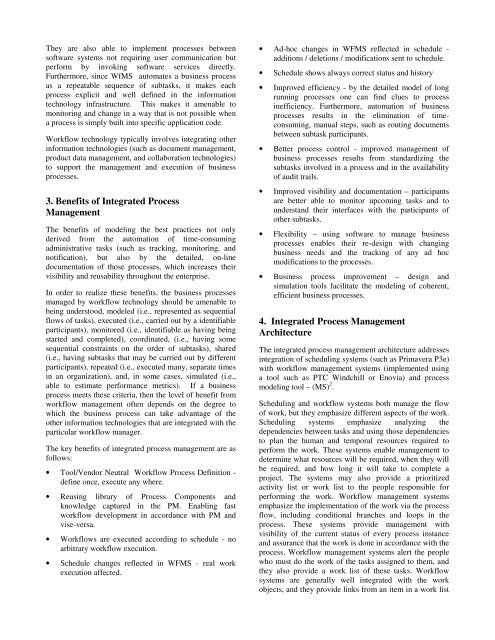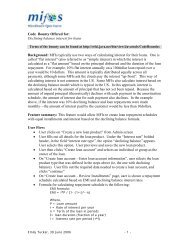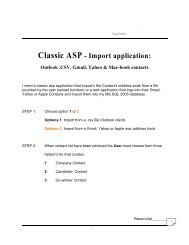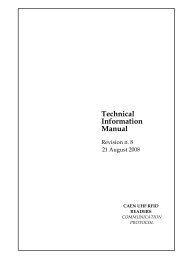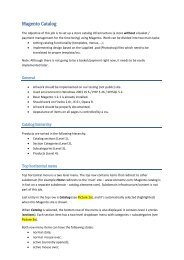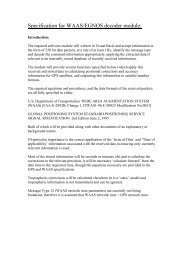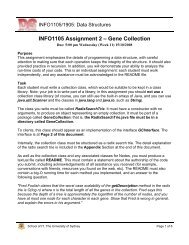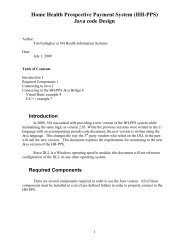Integrated process management: from planning to work execution
Integrated process management: from planning to work execution
Integrated process management: from planning to work execution
Create successful ePaper yourself
Turn your PDF publications into a flip-book with our unique Google optimized e-Paper software.
They are also able <strong>to</strong> implement <strong>process</strong>es between<br />
software systems not requiring user communication but<br />
perform by invoking software services directly.<br />
Furthermore, since WfMS au<strong>to</strong>mates a business <strong>process</strong><br />
as a repeatable sequence of subtasks, it makes each<br />
<strong>process</strong> explicit and well defined in the information<br />
technology infrastructure. This makes it amenable <strong>to</strong><br />
moni<strong>to</strong>ring and change in a way that is not possible when<br />
a <strong>process</strong> is simply built in<strong>to</strong> specific application code.<br />
Workflow technology typically involves integrating other<br />
information technologies (such as document <strong>management</strong>,<br />
product data <strong>management</strong>, and collaboration technologies)<br />
<strong>to</strong> support the <strong>management</strong> and <strong>execution</strong> of business<br />
<strong>process</strong>es.<br />
3. Benefits of <strong>Integrated</strong> Process<br />
Management<br />
The benefits of modeling the best practices not only<br />
derived <strong>from</strong> the au<strong>to</strong>mation of time-consuming<br />
administrative tasks (such as tracking, moni<strong>to</strong>ring, and<br />
notification), but also by the detailed, on-line<br />
documentation of those <strong>process</strong>es, which increases their<br />
visibility and reusability throughout the enterprise.<br />
In order <strong>to</strong> realize these benefits, the business <strong>process</strong>es<br />
managed by <strong>work</strong>flow technology should be amenable <strong>to</strong><br />
being unders<strong>to</strong>od, modeled (i.e., represented as sequential<br />
flows of tasks), executed (i.e., carried out by a identifiable<br />
participants), moni<strong>to</strong>red (i.e., identifiable as having being<br />
started and completed), coordinated, (i.e., having some<br />
sequential constraints on the order of subtasks), shared<br />
(i.e., having subtasks that may be carried out by different<br />
participants), repeated (i.e., executed many, separate times<br />
in an organization), and, in some cases, simulated (i.e.,<br />
able <strong>to</strong> estimate performance metrics). If a business<br />
<strong>process</strong> meets these criteria, then the level of benefit <strong>from</strong><br />
<strong>work</strong>flow <strong>management</strong> often depends on the degree <strong>to</strong><br />
which the business <strong>process</strong> can take advantage of the<br />
other information technologies that are integrated with the<br />
particular <strong>work</strong>flow manager.<br />
The key benefits of integrated <strong>process</strong> <strong>management</strong> are as<br />
follows:<br />
• Tool/Vendor Neutral Workflow Process Definition -<br />
define once, execute any where.<br />
• Reusing library of Process Components and<br />
knowledge captured in the PM. Enabling fast<br />
<strong>work</strong>flow development in accordance with PM and<br />
vise-versa.<br />
• Workflows are executed according <strong>to</strong> schedule - no<br />
arbitrary <strong>work</strong>flow <strong>execution</strong>.<br />
• Schedule changes reflected in WFMS - real <strong>work</strong><br />
<strong>execution</strong> affected.<br />
• Ad-hoc changes in WFMS reflected in schedule -<br />
additions / deletions / modifications sent <strong>to</strong> schedule.<br />
• Schedule shows always correct status and his<strong>to</strong>ry<br />
• Improved efficiency - by the detailed model of long<br />
running <strong>process</strong>es one can find clues <strong>to</strong> <strong>process</strong><br />
inefficiency. Furthermore, au<strong>to</strong>mation of business<br />
<strong>process</strong>es results in the elimination of timeconsuming,<br />
manual steps, such as routing documents<br />
between subtask participants.<br />
• Better <strong>process</strong> control - improved <strong>management</strong> of<br />
business <strong>process</strong>es results <strong>from</strong> standardizing the<br />
subtasks involved in a <strong>process</strong> and in the availability<br />
of audit trails.<br />
• Improved visibility and documentation – participants<br />
are better able <strong>to</strong> moni<strong>to</strong>r upcoming tasks and <strong>to</strong><br />
understand their interfaces with the participants of<br />
other subtasks.<br />
• Flexibility – using software <strong>to</strong> manage business<br />
<strong>process</strong>es enables their re-design with changing<br />
business needs and the tracking of any ad hoc<br />
modifications <strong>to</strong> the <strong>process</strong>es.<br />
• Business <strong>process</strong> improvement – design and<br />
simulation <strong>to</strong>ols facilitate the modeling of coherent,<br />
efficient business <strong>process</strong>es.<br />
4. <strong>Integrated</strong> Process Management<br />
Architecture<br />
The integrated <strong>process</strong> <strong>management</strong> architecture addresses<br />
integration of scheduling systems (such as Primavera P3e)<br />
with <strong>work</strong>flow <strong>management</strong> systems (implemented using<br />
a <strong>to</strong>ol such as PTC Windchill or Enovia) and <strong>process</strong><br />
modeling <strong>to</strong>ol – (MS) 2 .<br />
Scheduling and <strong>work</strong>flow systems both manage the flow<br />
of <strong>work</strong>, but they emphasize different aspects of the <strong>work</strong>.<br />
Scheduling systems emphasize analyzing the<br />
dependencies between tasks and using those dependencies<br />
<strong>to</strong> plan the human and temporal resources required <strong>to</strong><br />
perform the <strong>work</strong>. These systems enable <strong>management</strong> <strong>to</strong><br />
determine what resources will be required, when they will<br />
be required, and how long it will take <strong>to</strong> complete a<br />
project. The systems may also provide a prioritized<br />
activity list or <strong>work</strong> list <strong>to</strong> the people responsible for<br />
performing the <strong>work</strong>. Workflow <strong>management</strong> systems<br />
emphasize the implementation of the <strong>work</strong> via the <strong>process</strong><br />
flow, including conditional branches and loops in the<br />
<strong>process</strong>. These systems provide <strong>management</strong> with<br />
visibility of the current status of every <strong>process</strong> instance<br />
and assurance that the <strong>work</strong> is done in accordance with the<br />
<strong>process</strong>. Workflow <strong>management</strong> systems alert the people<br />
who must do the <strong>work</strong> of the tasks assigned <strong>to</strong> them, and<br />
they also provide a <strong>work</strong> list of these tasks. Workflow<br />
systems are generally well integrated with the <strong>work</strong><br />
objects, and they provide links <strong>from</strong> an item in a <strong>work</strong> list


